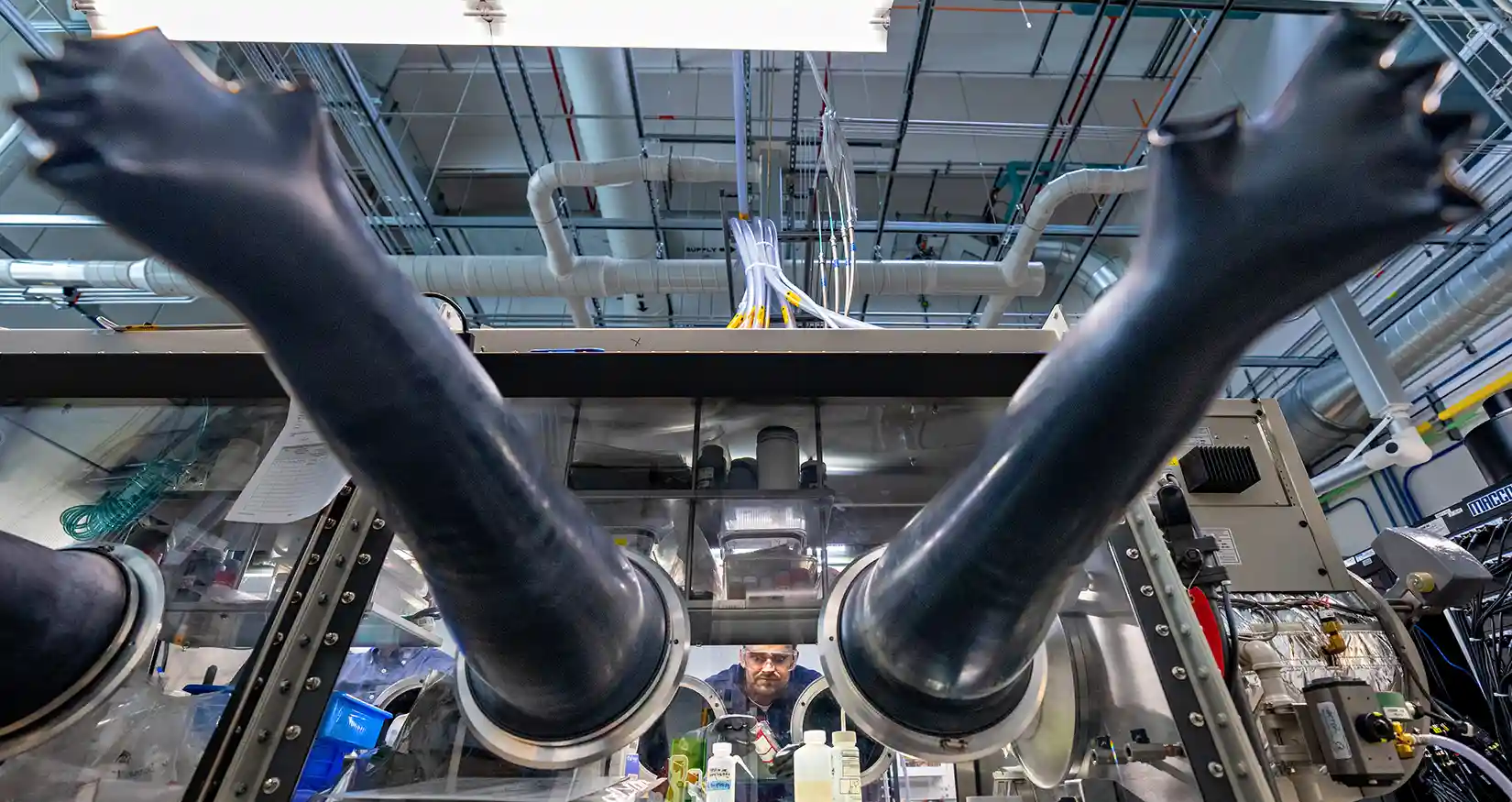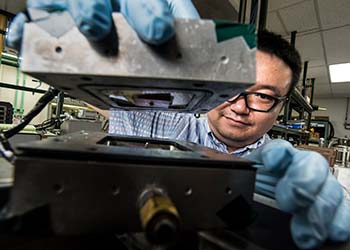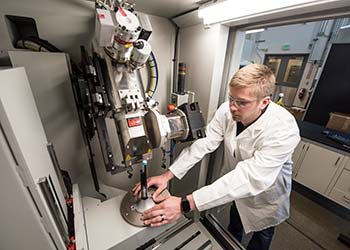Energy Storage Facilities
NLR's research facilities and equipment help component developers and manufacturers improve battery and energy storage system designs by enhancing performance and extending battery life.

Sophisticated characterization, modeling, and analysis tools make it possible for researchers to examine energy storage solutions from the material to the system level, with a focus on safety, reliability, and durability. NLR offers several capabilities unique to the national laboratory system, including award-winning innovations, cutting-edge X-ray diagnostic equipment, and NLR-designed machine learning models.
NLR's R&D 100 Award-winning Isothermal Battery Calorimeters are the only tools able to determine heat levels and battery energy efficiency within 98% of actual values. Researchers use these state-of-the-art calorimeters and the equipment described below to support NLR's research to develop next-generation batteries and energy storage systems.
Researchers use the Energy Systems Integration Facility (ESIF) to explore the interconnections between battery applications, charging and energy control
technologies, buildings, and grid infrastructure to conduct megawatt-scale R&D examining integration of power grids, buildings, vehicles, charging systems, and energy storage systems. The ESIF provides the resources necessary to develop, assess,
and prove energy storage system performance and compatibility with distributed energy systems.
NLR is also developing an advanced hardware-in-the-loop (HIL) platform for ˜10 kW grid-connected storage systems. Incorporating a simulated distribution feeder and physical grid and photovoltaic (PV) simulators, this HIL system will be able to evaluate standalone and PV-integrated energy storage systems (batteries and inverters) under real-world conditions. This will enable quantification of real-world performance of both energy storage hardware and the grid it is intended to support, without risking disruption of service or damage to hardware when evaluating developmental systems and control strategies.
NLR's array of electrochemical characterization equipment is used to assess the fundamental cell and module characteristics critical to material development, model building, and validation efforts. The tools below are used to evaluate materials and small cells, quantifying how the design of cathodes, anodes, binders, current collectors, electrolytes, and separators affect overall system performance.
Micro Calorimeter

NLR has added a patented Micro Calorimeter to its existing family of R&D 100 Award-winning Isothermal Battery Calorimeters (IBCs). The Micro Calorimeter examines the thermal signature of battery chemistries early on in the design cycle using popular coin cell and small pouch cell designs, which are simple to fabricate and study. Fundamental analysis of material limitations at the coin-cell level gives engineers, materials researchers, manufacturers, innovators, labs, and universities the ability to experiment with a wide range of chemistries and determine which variations and combinations work best in an actual battery setting.
Micro Calorimeter Highlights and Capabilities:
- Examines new chemistries in small format cells, small electronics, wearable devices, and sensors
- In operando measurement of reaction heats within individual cells under actual load cycles
- Flexible chamber design accommodates testing of different cell sizes at a consistent, known pressure
- Evaluates kinetic and thermal properties from frequency response analysis
- Powerful tool for early-stage materials R&D to assess material stability and compatibility across multiple cell components
- Analyzes cell abuse kinetics mechanisms, as well as thermal limitations under normal operation
- Ideal for studying engineering modifications (coating effects, thermal interfaces, contact impedance at interconnects, porosity changes, wetting, binder adhesion)
- U.S. Patent #14/855,538; software for post-processing: NLR-SWR-13-15
Differential Scanning Calorimeter
The differential scanning calorimeter (DSC) measures the thermal properties of materials used in batteries, particularly lithium-ion (Li-ion) electrolytes, cathodes, and anodes. This capability is particularly useful for input to NLR's 3-D thermal abuse model, including evaluation of how atomic layer deposition affects abuse characteristics associated with Li-ion cathodes and anodes. The DSC has been used extensively to measure the crystallinity of the polymeric components, melting points, onset temperatures for reactions, and heat capacity of battery components. The heat capacity data are then used in NLR's extensive suite of thermal models for various battery chemistries.
Accelerating Rate Calorimeter
This device measures exotherm onset of reacting materials and batteries with exceptional sensitivity at various heating rates (up to 100°C/min). The battery heat output, temperature, and pressure can be measured while the battery is shorted, over-charged, over-discharged, or abused. The base unit can assess small samples of 5 mg to laptop cells (.70" D x 2.56" H). The EV extension unit measures samples as large as HEV batteries (9.8" D x 19.68" H). The accelerating rate calorimeter is ideal for evaluating NLR's internal short circuit device. It can evaluate how features incorporated into the cell affect the cell's overall safety performance.
Electrochemical Impedance Spectroscopy System
AC-impedance spectroscopy, an important and powerful method for studying surface processes, involves the measurement of the frequency dispersion of the impedance or admittance of a system. One advantage of measurements in the frequency domain is that the frequency dispersion of the complex impedance may be analyzed by modeling the interface as a collection of ideal circuit elements comprising a simple equivalent circuit. The various circuit elements can then be related to features of the system under study such as ionic conductivity, solution resistance, double layer capacitance, and Warburg diffusion. NLR has electrochemical impedance spectroscopy (EIS) systems that span a wide range of frequencies from 10 MHz to 1 μHz. The EIS units at NLR have been essential in developing mass diffusion characteristics for silicon anodes and for developing modelling parameters for a lithium-air (Li-air) cell.
Thermal Conductivity Meters
NLR uses two thermal conductivity meters to assess the thin film and bulk thermal conductivity of electrodes, cathodes, anodes, and batteries. These meters measure the thermal diffusivity of the materials, and this information, along with the heat capacity from the DSC, allows accurate thermal models to be developed for energy storage systems.
Potentiostats
NLR has several potentiostats with the current range spanning + 100 nA to + 1 A and a voltage range of + 10 V—which are particularly suitable for the high-voltage Li-ion based chemistries. These are used to perform GITT/PITT experiments to characterize transport limitations in battery electrodes, in addition to program custom scan-profiles for new-chemistry evaluation. Bipotentiostats are available to individually control two working electrodes in four-probe studies.
Cyclic Voltammetry
NLR extensively uses cyclic voltammetry to characterize redox behavior and to investigate reaction mechanisms associated with electrochemical energy storage. Cyclic voltammetry is very useful in determining how changes to a cell's chemistry can affect the reversibility of the reactions and whether unwanted reactions are occurring within the cell during cycling. Cyclic voltammetry is an essential tool used to study redox processes, stability of reaction products, and electron transfer kinetics.
Ionic Conductivity Meters
YSI 3200 conductivity meters are used to characterize battery electrolytes. The conductivity of lithium ions in the electrolyte changes dramatically with composition and temperature of the electrolyte, and is the predominant factor influencing cell performance, particularly at sub-zero temperatures. Conductivity meters with built-in temperature compensation provide a means to directly characterize electrolyte resistance. A pH monitoring accessory measures dryness of the electrolyte.
Rotating Ring-Disc Electrodes
NLR has a dedicated rotating ring-disc electrode (RRDE) for characterizing transport properties in air-sensitive redox systems. The RRDE experiments provide the ability to individually quantify migration and diffusion limitations within an electrolyte and are often used to measure diffusivity of ions in the electrolyte. This system is also used to characterize surface modifications to particles, the effect of catalysts in Li-air batteries, and redox intermediates in non-standard chemistries.
Low Current Cyclers
In addition to an extensive range of battery cyclers, NLR has more than 150 Arbin channels that are dedicated to materials research. Researchers routinely characterize new Li-2 materials in cell sizes ranging from a few micro-ampere-hours up to 1 Ah on these channels. Temperature-controlled baths that range from -20°C to 60°C are available to maintain constant surface temperatures on the cells.
| Cycler | Number of Channels | Voltage Range (Volts) | Channel Current Range (Amps) |
|---|---|---|---|
| Arbin – 1 | 32 | +10 /-10 | ±0.5 |
| Arbin – 2 | 32 | +10 /-10 | ±0.50 |
| Arbin – 3 | 104 | + 10 /-5 | ±2 |
NLR's extensive facilities are used to evaluate and design efficient energy storage systems, as well as battery cells, modules, and packs. Researchers use a combination of tools listed below to put these energy storage components through their paces. Most cell-level tests use Bitrode or Arbin software for basic data logging and management. For more complex module or pack cycling, as well as for calorimetry evaluations, these tools are augmented with data acquisition hardware from National Instruments and custom-developed Labview applications.
Calorimeters
Calorimeters provide critical heat generation and efficiency data for energy storage systems. Previously, battery manufacturers could only estimate the round-trip efficiency of a battery through electrical measurements. NLR's calorimeters measure heat directly, allowing it to be used to independently determine batteries' efficiency under both charge and discharge currents. The data from these calorimeters are critical to the accurate design of thermal management systems and optimizing operational conditions. Three customized NLR calorimeters allow heat to be measured from cells, modules, and small battery packs. NLR's calorimeters can also be used to measure the joule heating and the entropic heating of cells and modules. Learn more about NLR's R&D 100 Award-winning Isothermal Battery Calorimeters.
| Specifications | IBC 284 (Cell) | Module IBC | Large-Volume IBC (Pack) |
|---|---|---|---|
| Maximum Voltage (Volts) | 50 | 500 | 600 |
| Sustained Maximum Current (Amps) | 250 | 250 | 450 |
| Excursion Currents (Amps) | 300 | 300 | 1,000 |
| Volume (liters) | 9.4 | 14.7 | 96 |
| Maximum Dimensions (cm) | 20.3 x 20.3 x 15.2 | 35 x 21 x 20 | 60 x 40 x 40 |
| Operating Temperature (°C) | -30 to 60 | -30 to 60 | -40 to 100 |
| Maximum Constant Heat Generation (W) | 50 | 150 | 4,000 |
Infrared Thermal Imaging
NLR performs infrared (IR) imaging of battery manufacturer's cells to determine areas of thermal concern. NLR combines the IR imaging equipment with a battery cycler to place the cells under various drive cycles, such as a US06 charge depleting cycle for a PHEV, to understand the temperature differences within the cell. Researchers then make recommendations to battery manufacturers on how to improve the thermal design of the cell to increase its cycle life and safety.
AeroVironment Dual Channel Battery Power Supplies
The bi-directional, computer-controlled two-channel DC power processing system is designed for evaluating (i.e., "cycling") electric and hybrid-electric vehicle components and subsystems. Additional instrumentation has been added to measure voltage and current accuracies of 1 mV and 10 mA, respectively. It has fully programmable power/voltage/current schedules. See a complete list of battery evaluation channels below.
Bitrode Battery Cyclers
The Bitrode cyclers are designed specifically for hybrid electric, electric, and fuel cell battery and ultracapacitor pack testing. Their voltages range from 0–100 volts, with a maximum current output of 500 amps. When multiple channels are placed in parallel, the maximum current output that can be attained is 1,200 amps. These cyclers can meet the most demanding drive-cycle profiles. The cycler channels are integrated with calorimeters, environmental chambers, and isothermal baths to better control and assess how temperature affects the energy storage systems under test. See a complete list of battery evaluation channels below.
| Cycler | Channels | Voltage (volts) | Current* (amps) | Power* (kW) |
|---|---|---|---|---|
| ABC-1000 | 2 | 8 to 440 | ±1000 | ±125 |
| AV-900 | 2 | 8 to 900 | ±1000 | ±250 |
| ABC-150 (a) | 2 | 8 to 440 | ±530 | ±125 |
| ABC-150 (b) | 2 | 8 to 440 | ±530 | ±125 |
| Bitrode – 100 | 4 | 0-100 | ±300 | ±30 |
| Bitrode – 72 | 1 | 0-72 | ±300 | ±22 |
| Bitrode – 36a | 12 | 0-36 | ±300 | ±11 |
| Bitrode – 36 | 2 | 0-36 | ±500 | ±18 |
| Bitrode – 24 | 3 | 0-24 | ±100 | ±2.4 |
| Bitrode – 12 | 1 | 0-12 | ±500 | ±6.0 |
| Bitrode – 6 | 1 | 0-6 | ±200 | ±1.2 |
| Bitrode – 5a | 32 | 0-5 | ±100 | ±0.5 |
| Bitrode – 5 | 16 | 0-5 | ±50 | ±0.25 |
* Current and power output depend on voltage and configuration of channels. Note that channels of a single machine can be paralleled to increase power, e.g., the ABC-1000's two 125 kW channels can be configured as one 250 kW channel.
Environmental Chambers and Isothermal Baths
The lab has seven chambers and several isothermal baths that maintain accurate temperature control (±0.1°C). Energy storage system performance is a function of ambient temperature, so evaluating technologies over a range of temperatures is essential for model validation. Energy storage researchers have access to additional larger chambers on the NLR campus.
| Chamber Size (ft3) | Number of Chambers | Interior Dimensions (Inches) | Temperature Range (°C) |
|---|---|---|---|
| 64 | 2 | 48 x 48 x 48 | -45°C to 190°C |
| 32 | 4 | 38 x 38 x 38 | -45°C to 190°C |
| 12.4 | 1 | 21 x 31 x 33 | -40°C to 150°C |
| 5.8 | 1 | 21 x 20 x 24 | -30°C to 100°C |
| 4.1 | 2 | 20 x 24 x 15 | -20°C to 85°C |
Materials synthesis lab capabilities include:
- Atomic layer deposition
- Electron spin resonance
- Nuclear magnetic resonance
- X-ray diffraction
- Inductively coupled plasma analysis
- Temperature-programmed desorption analysis
- Volumetric capacity analysis
- Thermal gravimetric analysis
- Ultrafast spectroscopy
- High magnetic field spectroscopy
- Optical spectroscopy
- Molecular beam epitaxy
- High-energy and reactive-species synthesis.
Custom-built apparatus for nanostructured materials synthesis research includes:
- Nd:YAG and Alexandrite pulsed laser vaporization systems
- Chemical vapor deposition systems
- Hot wire chemical vaporization system
- Atomic layer deposition system
- Sputter/evaporation deposition chamber.
Research facilities for Li-air batteries are designed to industry standards, with air-cathode and catalysts. NLR's differential scanning calorimeter is used to measure the thermal properties of energy storage materials. NLR also conducts density functional theory (DFT) modeling at the atomic level, an inexpensive and efficient method for performing mechanistic studies and the predictive design of materials.

CT scanner technology allows for non-destructive, high-precision, and high-speed inspection for applications in energy storage, power electronics, photovoltaics, hydrogen, and basic sciences. This state-of-the-art X-ray imaging system housed in the Materials Characterization Lab in the ESIF has the following capabilities:
- Advanced 2D X-ray inspection
- 2D CT Slice reconstruction
- CT volume reconstruction for 3D inspection
- 3D internal and external surface scanning
- Measurement and analysis tools
- 360-degree rotation
- Tomography scanning (using vortex spiral CT, which is an automated single pass computed tomography scanning technique utilizing spiral acquisition and reconstruction with a digital flat-panel detector)
NLR's Cell Fabrication, Analysis, and Breakdown Laboratory contains a variety of materials and 10 machines to build customized, multilayer batteries, such as coin cells and pouch cells. These batteries are then evaluated and analyzed to ensure they will meet safety and performance requirements before being produced in mass quantities. With a sub-zero (-65°C) analysis chamber and a coating machine that reaches extremely high temperatures, the lab is home to some of the coldest and hottest equipment at NLR.
Share
Last Updated Jan. 2, 2026
